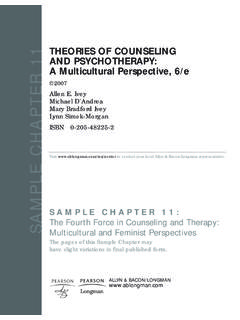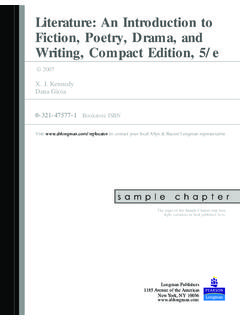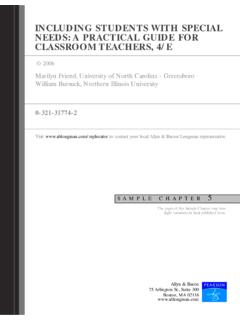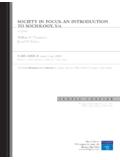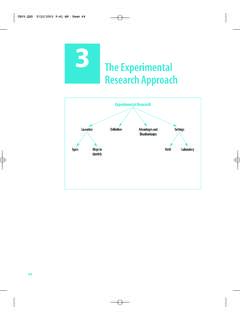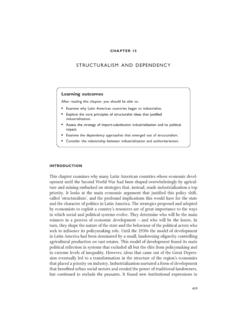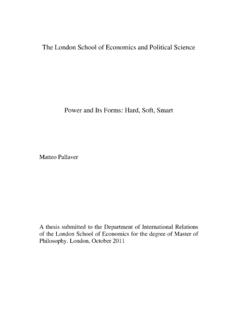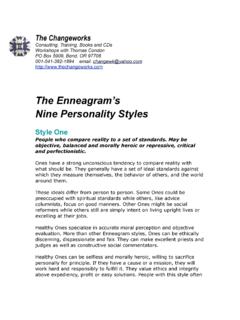Transcription of Gender Stereotypes: Masculinity and Femininity
1 From white men can t jump to girls can t do math, negative images that are pervasivein the culture can make us choke during tests of ability.. The power of stereotypes , sci-entists had long figured, lay in their ability to change the behavior of the person holding thestereotype.. But five years ago, Stanford University psychologist Claude Steele showedsomething else: It is the targets of a stereotype whose behavior is most powerfully affectedby it. A stereotype that pervades the culture the way ditzy blondes and forgetful seniors do makes people painfully aware of how society views them so painfully aware, in fact,that knowledge of the stereotype can affect how well they do on intellectual and othertasks. (Begley, 2000, pp. 66 67)According to Sharon Begley (2000), stereotypes present a trap into which many peoplecan fall.
2 In 1995, Claude Steele and Joshua Aronson reported on a study that showed howthe existence of negative stereotypes affects those who are part of the stereotyped proposed that people feel threatened in situations in which they believe that their per-formance will identify them as examples of their group s negative stereotype. Steele andAronson labeled this situation stereotype threatbecause the presence of these negativestereotypes threatens performance and self-concept. Even if the person does not believe thestereotype or accept that it applies, the threat of being identified with a negative stereotypecan be an ever-present factor that puts a person in the spotlight and creates tension and anx-iety about setting up a situation that manipulated expectations of the implications of takinga test, Steele and Aronson showed that those expectations affected participants perfor-mance.
3 For example, African Americans who believed that the test they were taking was atest of basic scholastic ability performed worse than African Americans who thought thetest was just another test. Women who believed that the mathematics test would reveal theirunderlying ability performed more poorly than women who had different beliefs about thetest s diagnostic ability (Steele, 1997). In addition, African Americans and women per-formed more poorly than White men, who are not threatened by negative stereotypes oftheir abilities in math. However, White men can be threatened by stereotypes of math abil-ity. A study (Smith & White, 2002) that reminded White men that Asians are superior atGender stereotypes : Masculinity and Femininity1597 TThhee SStteerreeoottyyppee TTrraappNewsweek,November 6, 2/26/2004 9:35 AM Page 159math provoked poorer performance on a math test.
4 Some people get a double dose ofstereotype threat, such as Latino women, who were affected by stereotype threat on a testof mathematical and spatial ability (Gonzales, Blanton, & Williams, 2002).Begley s (2000) article included examples of how widespread stereotype threat maybe, how easily stereotype threat can be summoned, and how powerful stereotypes are inaffecting performance. Reminding people of their membership in a stereotyped group, suchas asking them to mark a question about their Gender just before starting the test, wasenough of a cue to affect performance negatively. However, when reminded of their affil-iation with a positively stereotyped group, Asian American women s math performance im-proved. Additional research (Smith & White, 2002) suggests that nullifying stereotypethreats may not be too difficult.
5 Just the suggestion that men and women perform equallywell on this test was enough to avert the effects of stereotype threat on a math thus can be a positive influence, but much more evidence indicates thatthey can do damage and require additional steps to nullify. This powerful process affectsboth those who impose the stereotypes and those who are the targets of Gender Roles to Gender StereotypesAs Chapters 5 and 6 explored, a Gender role consists of activities that men and women en-gage in with different frequencies. For example, in the United States, repairing cars and re-pairing clothing are associated predominantly with men and women, respectively. Thesegender-related behaviors thus become part of a pattern accepted as masculine or feminine,not because of any innate reason for these differences, but because of the association withwomen and Gender stereotypeconsists of beliefs about the psychological traits and charac-teristics of, as well as the activities appropriate to, men or women.
6 Gender roles are de-fined by behaviors, but Gender stereotypes are beliefs and attitudes about Masculinity andfemininity. The concepts of Gender role and Gender stereotype tend to be related. Whenpeople associate a pattern of behavior with either women or men, they may overlook indi-vidual variations and exceptions and come to believe that the behavior is inevitably asso-ciated with one Gender but not the other. Therefore, Gender roles furnish the material forgender stereotypes are very influential; they affect conceptualizations of women andmen and establish social categories for Gender . These categories represent what peoplethink, and even when beliefs vary from reality, the beliefs can be very powerful forces injudgments of self and others, as the headline story for this chapter showed. Therefore, thehistory, structure, and function of stereotypes are important topics in understanding the im-pact of Gender on people s of Women and MenChapter 6 discussed children s acceptance of the rigid formulation of what is acceptablefor women and men, but Gender stereotyping is not unique to children or even to contem-160 Chapter 7 Gender stereotypes : Masculinity and 2/26/2004 9:35 AM Page 160porary society.
7 The current Gender stereotypes , especially those about women, reflect be-liefs that appeared during the 19th century, the Victorian era (Lewin, 1984c). Before the19th century, most people lived and worked on farms where men and women worked to-gether. The Industrial Revolution changed the lives of a majority of people in Europe andNorth America by moving men outside the home to earn money and leaving women athome to manage households and children. This separation was unprecedented in history,forcing men and women to adapt to different environments and roles. As men coped withthe harsh business and industrial world, women were left in the relatively unvarying andsheltered environments of their homes. These changes produced two beliefs: the Doctrineof Two Spheres and the Cult of True Doctrine of Two Spheres is the belief that women s and men s interests diverge women and men have their separate areas of influence (Lewin, 1984a).
8 For women, theareas of influence are home and children, whereas men s sphere includes work and the out-side world. These two spheres are different, with little overlap, forming opposite ends ofone dimension. This conceptualization of opposition forms the basis not only for socialviews of Gender , but also for psychology s formulation of the measurement of masculinityand Cult of True Cult of True Womanhood arose between 1820 and1860. The attributes of True Womanhood, by which a woman judged herself and wasjudged by her husband, her neighbors, and society could be divided into four cardinalvirtues piety, purity, submissiveness, and domesticity (Welter, 1978, p. 313). Women smagazines and religious literature of the 19th century furnished evidence of society s em-phasis on these four areas. The Cult of True Womanhood held that the combination of thesecharacteristics provided the promise of happiness and power to the Victorian woman, andwithout these no woman s life could have real first virtue was piety, which originated with society s view of women as more nat-urally pious than men.
9 Women s natural superiority also appeared in their refinement, deli-cacy, and tender sensibilities. Religious studies were seen as compatible with Femininity anddeemed appropriate for women, whereas other types of education were thought to detractfrom women s Femininity . These other types of education included studying through formalmeans and even reading romantic novels either of which might lead women to ignore re-ligion, become overly romantic, and lose their virtue or purity (that is, their virginity).Although women were seen as uninterested in sex, they were vulnerable to seduc-tion. The loss of the second virtue, purity, was a fate worse than death. Having lost herpurity, a woman was without value or hope: Purity was as essential as piety to a youngwoman, its absence as unnatural and unfeminine. Without it she was, in fact no woman atall, but a member of some lower order (Welter, 1978, p.)
10 315).Men, on the other hand, were not naturally as religious and thus not naturally as vir-tuous as women. According to this view of True Womanhood, men were, at best, prone tosin and seduction, and at worst, brutes. True Women would withstand the advances of men,dazzling and shaming them with their virtue. Men were supposed to be both religious andpure, although not to the same extent as women, and through association with TrueWomen, men could increase their own virtue. True Women could elevate 7 Gender stereotypes : Masculinity and 2/26/2004 9:35 AM Page 161 The third virtue of the Cult of True Womanhood was submissiveness, a characteris-tic not true of and not desirable in men (Welter, 1978). Women were expected to be weak,dependent, and timid, whereas men were supposed to be strong, wise, and forceful. De-pendent women wanted strong men, not sensitive ones.
